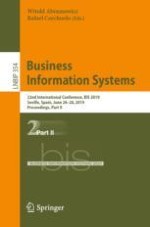The two-volume set LNBIP 353 and 354 constitutes the proceedings of the 22nd International Conference on Business Information Systems, BIS 2019, held in Seville, Spain, in June 2019.
The theme of the BIS 2019 was "Data Science for Business Information Systems", inspiring researchers to share theoretical and practical knowledge of the different aspects related to Data Science in enterprises. The 67 papers presented in these proceedings were carefully reviewed and selected from 223 submissions.
The contributions were organized in topical sections as follows:
Part I: Big Data and Data Science; Artificial Intelligence; ICT Project Management; and Smart Infrastructure.
Part II: Social Media and Web-based Systems; and Applications, Evaluations and Experiences.
